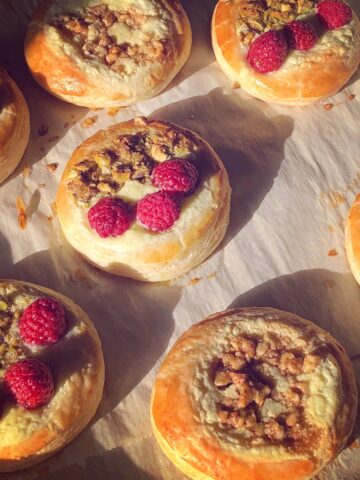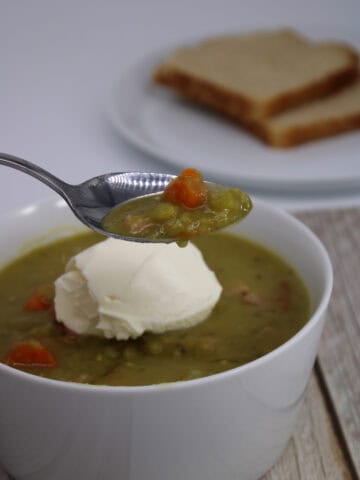There seemed to have been a boom in popularity for lemon-flavored dishes in the early 19th century, which included Shaker Lemon Pie and French tartes au citron. I assume these were an inspiration to Mrs. Elizabeth Goodfellow, developer of the first officially named "lemon meringue pie," pastry queen, and proprietress of America's first cooking school. There are few true American inventions in the food world, largely because we showed up on the map much later than everyone else. But the consensus seems to be that Lemon Meringue Pie is one of those rarities.
I like lemon meringue pie to have a sharp citrus bite to offset the delicate sweetness of the meringue. The addition of the lavender adds another subtle sensory level, and a little extra depth to the flavor of regular meringue. I like to think that my Grandpa (whose favorite pie was lemon meringue) would have thought the lavender was an amusing, but worthwhile addition.

Notes
- Crust: If you're making the crust from scratch, you'll want to bake it ahead of time before adding the filling. The pie is only in the oven long enough to brown the meringue, so not at all long enough to truly bake the crust. I often make the crust the day before, and then it's ready to go so I can add the filling while it's still hot.
- Lemons vs Lemon Juice: You can absolutely use bottled lemon juice for this recipe, but I have never found it to be as sharp and tangy as juice from the fruit itself. If you want a more mild flavor, bottled juice is great. But if you're wanting something bold, I recommend juicing some actual lemons, or adding in the optional yuzu juice for a superpowered pie.
- Lavender: Lavender can be overwhelming if you use too much, and many people describe it as tasting "soapy" if done poorly. The lavender flavor here is present, but subtle, and I don't recommend increasing the amount of lavender.
- Oven vs Torch: If you don't want to bother with using the oven twice (once for the pie crust and once to brown the meringue), you can skip it entirely if you have a kitchen torch on hand. A quick blast of butane will brown the meringue nicely, and you can get right to serving. Just make sure to hold the torch far away from the meringue at first, and then move slowly closer until you reach the right distance.
Storage
You can store a lemon meringue pie in the fridge if you need to. Just be aware the meringue can sometimes bead or "weep" in the cold temperature. It doesn't affect the flavor, just the cosmetics. If you bake and serve the same day, it's perfectly fine to leave it on the counter for a while. But I do recommend refrigerating any leftovers. Stick a piece of plastic wrap to the cut side of the pie, and put it in the fridge. It will keep for 2-3 days that way.
FAQ
Check out our recipe here.
Related
Looking for other recipes like this? Try these:

Grace Says:
You will end up with 4 extra egg yolks from this recipe. I usually either make something with custard in the coming days, or I just make a yolks-only omelet for breakfast the next day.
📖 Recipe

Lavender Lemon Meringue Pie
Ingredients
Lemon Filling
- 4 egg yolks
- ⅓ cup corn starch
- 1 ⅓ cups sugar
- 1 ½ cups water
- ¼ t salt
- 3 T unsalted butter
- ½ cup lemon juice
- 1 T lemon zest
- 1 T yuzu juice (optional)
Lavender Meringue
- 8 egg whites
- ¼ t cream of tartar
- 4 T sugar
- 1 t dried culinary lavender
Instructions
Lemon Filling
- Preheat oven to 375℉, and move rack to middle position. Separate the eggs to get your yolks, and whisk them. In a medium-sized saucepan, add the cornstarch, water, sugar, salt, and lemon zest. Cook on medium heat, whisking constantly until it comes to a boil. Boil for 1 minute, then turn down the heat to low. Slowly pour in the eggs, whisking constantly. Once the eggs are incorporated, remove from the heat and stir in the butter, lemon juice, and yuzu juice if you're using it.Allow the filling to sit and steam off for 10-15 minutes while you make the meringue. When it's ready, you will pour into your pre-baked pie crust while still hot and then cover with the meringue.
Lavender Meringue
- Add the sugar and lavender to a blender or food processor and pulse for 10-15 seconds. The lavender should be broken up into smaller pieces. The sugar might be slightly powdered, and that's ok.
- Beat the egg whites and cream of tarter with the whisk attachment of your mixer until you get soft peaks. Soft peaks will have some shape, but will flop over if you try to hold them upright. At this point, slowly add the sugar while beating. Continue to beat until you get stiff meringue. Peaks should hold themselves up when stood upright, the meringue should look glossy, and you should be able to hold the bowl upside down without it falling out.
- When the pie filling has been added to the pie crust, top it with the meringue. Pile it up high, and shape how you like. Make sure to seal the edges by ensuring there are no gaps between the meringue and the crust. This will help with shrinkage.
Assembly and Baking
- After the hot filling has been added to the pre-baked crust and the meringue piled on top, bake for 12-15 mins, or until the meringue is golden brown to your liking. It may help to rotate the pie in your oven after 8-10 mins to ensure even browning.Then remove the pie and place on a cooling rack until absolutely cool, at least 2 hours. Then slice and serve.









Did you make this recipe? Let me know!